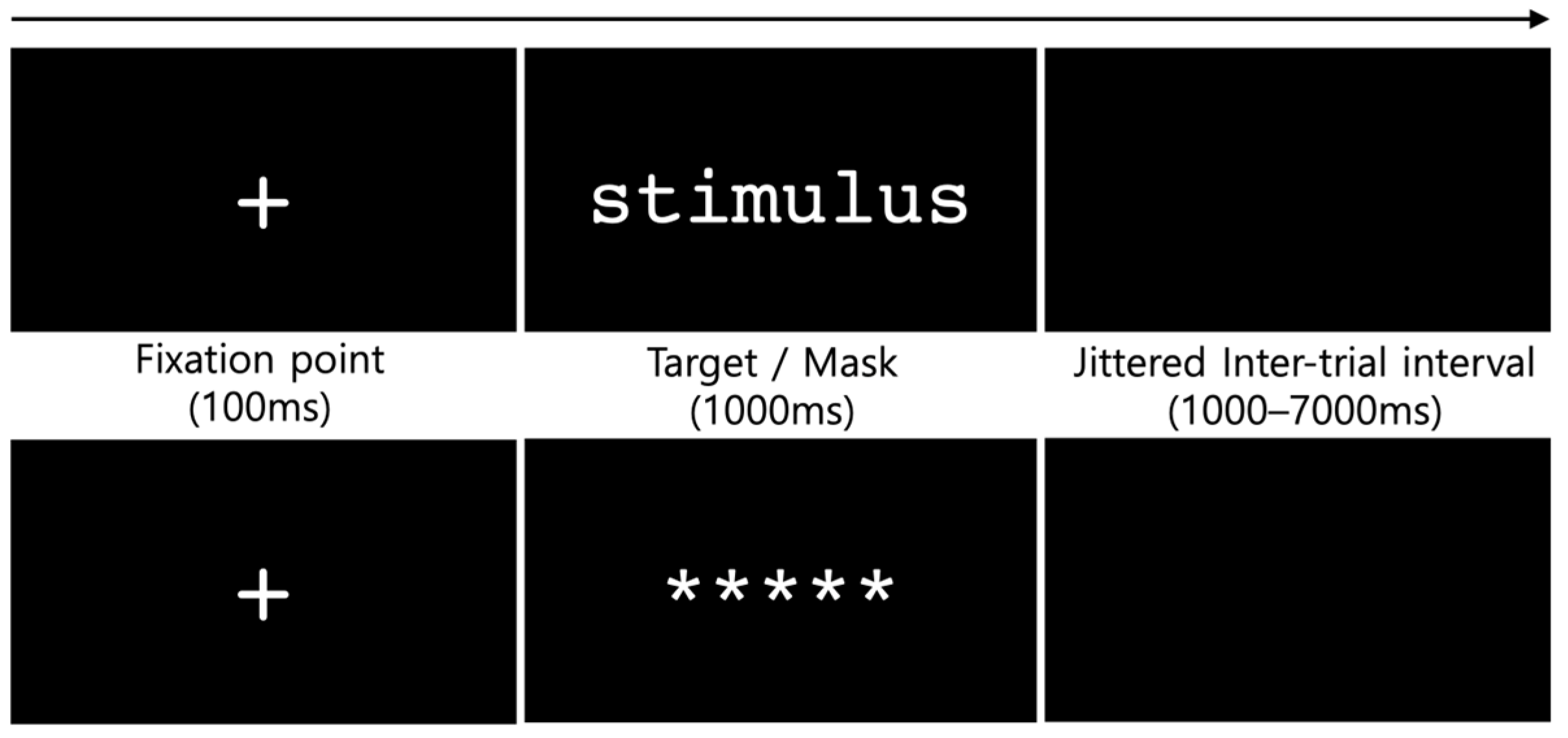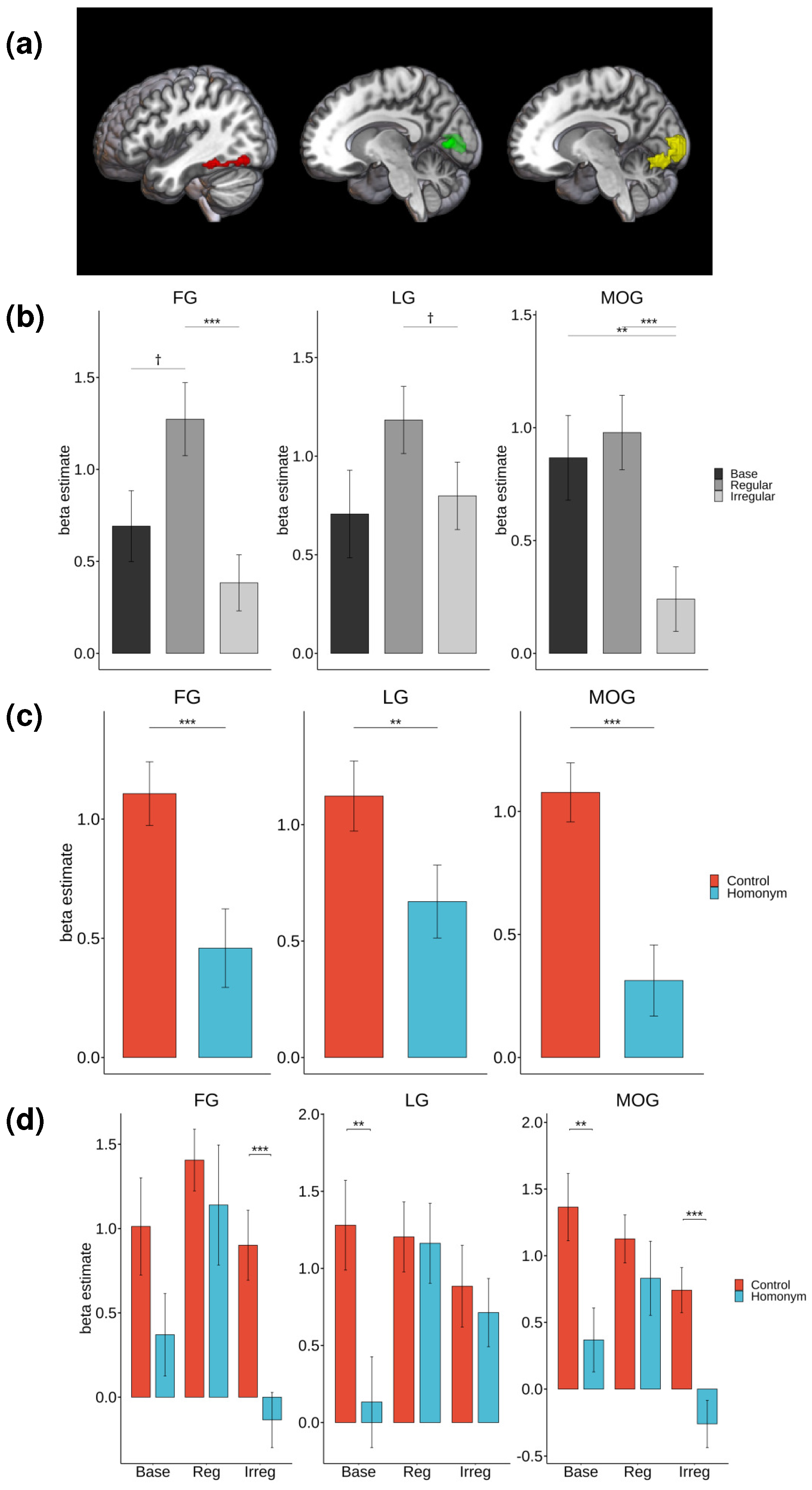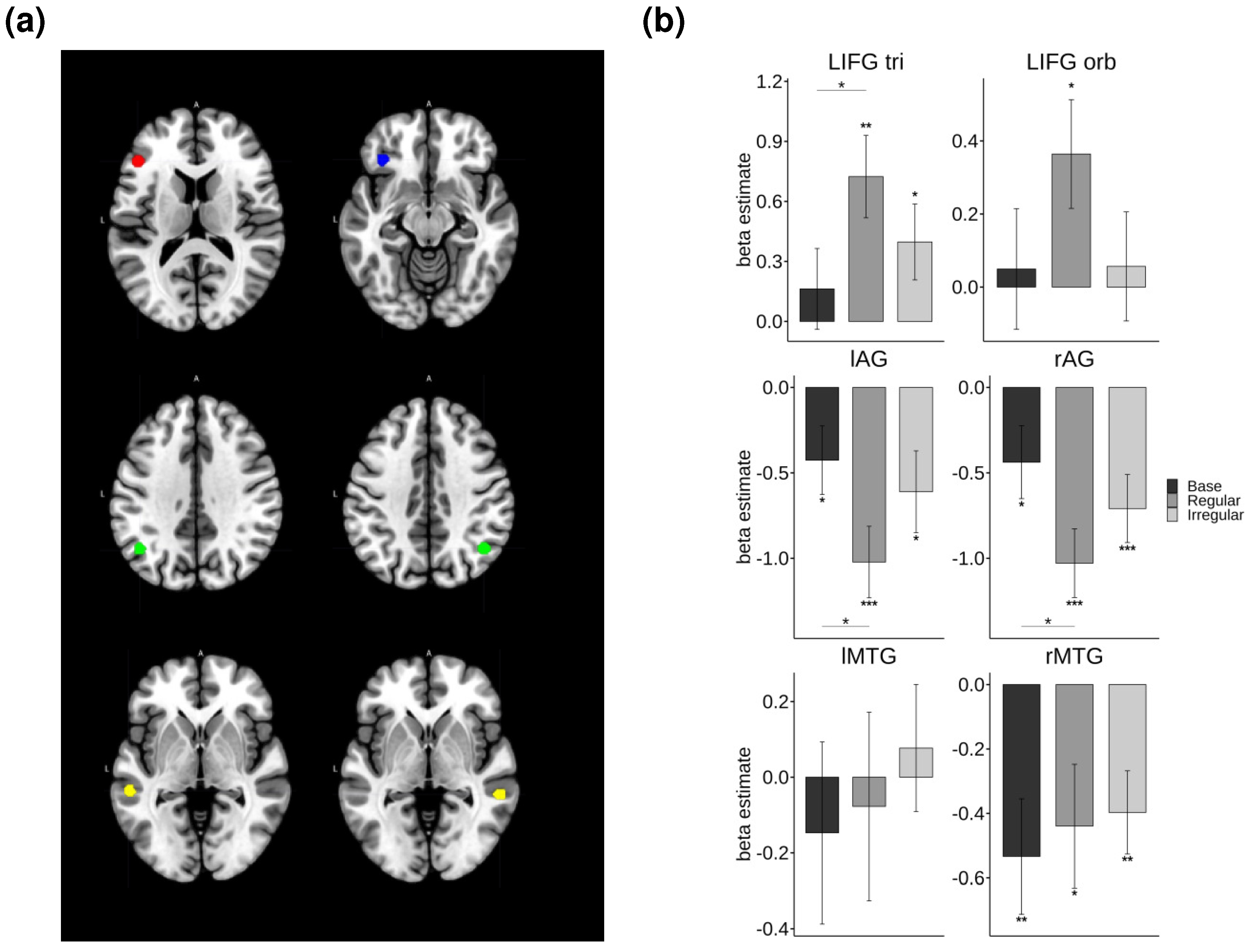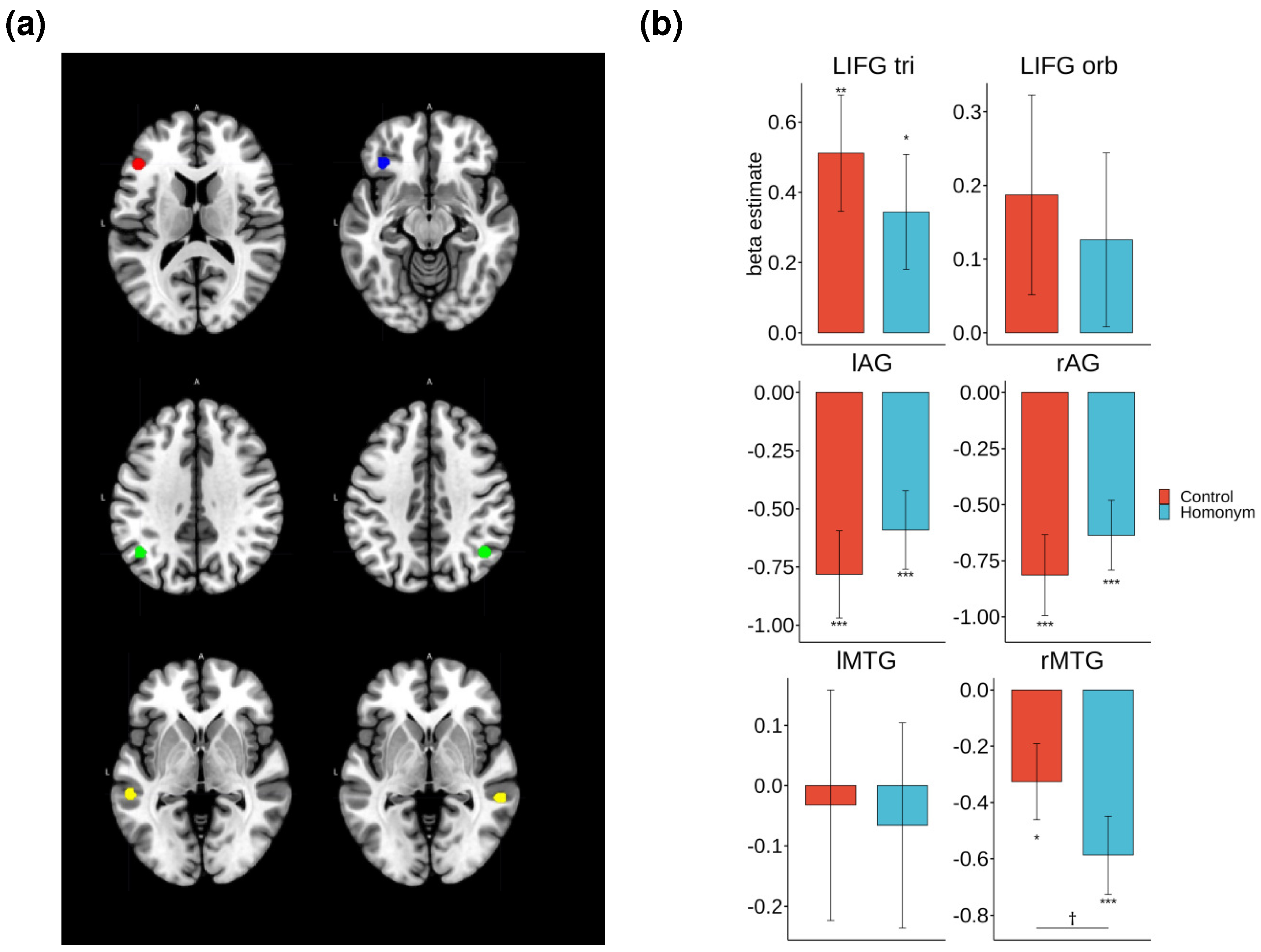Neural Dynamics of Processing Inflectional Morphology: An fMRI Study on Korean Inflected Verbs
Abstract
:1. Introduction
2. Materials and Methods
2.1. Participants
2.2. Materials
2.3. Procedure
2.4. Image Acquisition
2.5. Behavioral Analysis
2.6. fMRI Analysis
2.6.1. Statistical Analysis
2.6.2. ROI Analysis
3. Results
3.1. Behavioral Results
3.2. GLM Results
3.3. ROI Results
4. Discussion
5. Conclusions
Supplementary Materials
Author Contributions
Funding
Institutional Review Board Statement
Informed Consent Statement
Data Availability Statement
Conflicts of Interest
Appendix A
| Base Control | Base Homonym | Regular Control | Regular Homonym | Irregular Control | Irregular Homonym |
|---|---|---|---|---|---|
| 씻다 | 갈다 | 죄어 | 감아 | 눠서 | 갈려 |
| 신다 | 깨다 | 찧어 | 걷어 | 썩혀 | 쳤어 |
| 끊다 | 들다 | 엮고 | 개서 | 기워 | 쪼여 |
| 좇다 | 뛰다 | 볶아 | 불지 | 붐벼 | 텄다 |
| 놀다 | 뜨다 | 꽂고 | 붓지 | 모셔 | 맞혀 |
| 낫다 | 맞다 | 믿니 | 빌지 | 는다 | 말려 |
| 뽑다 | 맡다 | 서라 | 빨면 | 도와 | 배겨 |
| 돌다 | 매다 | 맺자 | 새자 | 실어 | 걷혀 |
| 참다 | 묻다 | 뚫어 | 켜며 | 굽혔다 | 멘다 |
| 씹다 | 받다 | 갚게 | 패지 | 놓쳤다 | 져도 |
| 찢다 | 쉬다 | 빚고 | 꾸어 | 어는가 | 졸려 |
| 얻다 | 타다 | 넣겠다 | 굽지 | 판다고 | 훔쳐 |
| 견디다 | 구르다 | 휘었고 | 거르고 | 저었고 | 감겼고 |
| 살피다 | 구하다 | 굴리지 | 배어도 | 뒀다 | 들려서 |
| 버티다 | 그리다 | 우기지 | 끼치고 | 뭉쳐서 | 바랬지 |
| 벌이다 | 달리다 | 감싸면 | 놀리자 | 박혔다 | 물려서 |
| 싸우다 | 따르다 | 다듬고 | 닥치지 | 치민다 | 써가며 |
| 부르다 | 부치다 | 넓히며 | 돋는다 | 샀고 | 일렀다 |
| 거닐다 | 빠지다 | 찾지만 | 싸놓고 | 꿴다 | 익혀서 |
| 다투다 | 울리다 | 닿았고 | 불리지 | 줬고 | 태웠다 |
| Pseudowords | |||||
|---|---|---|---|---|---|
| 닥든 | 멜쳐 | 폐진 | 혈긴 | 치오든 | 기까래 |
| 긴들 | 어빌 | 출다 | 칫자 | 싸치곤 | 잡우는 |
| 애건 | 벽다 | 치펴 | 드잘 | 기휠지 | 설기건 |
| 바면 | 새룬 | 먹낼 | 펴잰 | 먹얹네 | 꺼담네 |
| 버닌 | 망갠 | 돛던 | 휘슨 | 이패든 | 뜯리던 |
| 취랜 | 다길 | 둘긴 | 다쉴 | 치린지 | 싸눌은 |
| 제깐 | 규며 | 슬신 | 시딘 | 까리니 | 지패게 |
| 곰다 | 푹인 | 취든 | 잠선 | 기힐지 | 암섰지 |
| 태려 | 채셔 | 키룬 | 잴출 | 씌희네 | 밑절까 |
| 네칠 | 석린 | 핏지 | 줄핀 | 우이어 | 높리던 |
| 펄다 | 쨉던 | 추랜 | 포실 | 졸켜니 | 치철지 |
| 몫다 | 닻다 | 급던 | 묵진 | 끼진가 | 뜨러니 |
| 꾀실 | 겅틸 | 둡는 | 으인다 | 기묻냐 | 닫내는 |
| 죄릴 | 귤던 | 찰댄 | 주갈라 | 씌지곤 | 먹우네 |
| 후나 | 우알 | 치핀 | 치놀까 | 골길까 | 기말지 |
| 껀든 | 덤네 | 팝자 | 키르냐 | 바몰면 | 꿰루곤 |
| 보난 | 긷서 | 매몬 | 박낸들 | 꼽운다 | 차물다 |
| 철다 | 지뺀 | 삽아 | 움나며 | 곯기든 | 가먹은 |
| 빗셔 | 달탄 | 볍자 | 살건다 | 설까던 | 팝는다 |
| 유길 | 유날 | 벗친 | 보힌대 | 기훔다 | 펴려요 |
References
- Butterworth, B. Lexical Representation. In Language Production Vol. 2.; Butterworth, B., Ed.; Academic Press: London, UK, 1983; pp. 257–294. [Google Scholar]
- Taft, M. Morphological Decomposition and the Reverse Base Frequency Effect. Q. J. Exp. Psychol. Sect. A Hum. Exp. Psychol. 2004, 57, 745–765. [Google Scholar] [CrossRef]
- Taft, M.; Forster, K.I. Lexical Storage and Retrieval of Prefixed Words. J. Verbal Learn. Verbal Behav. 1975, 14, 638–647. [Google Scholar] [CrossRef]
- Clahsen, H. Lexical Entries and Rules of Language: A Multidisciplinary Study of German Inflection. Behav. Brain Sci. 1999, 22, 991–1013. [Google Scholar] [CrossRef] [PubMed]
- Pinker, S. Rules of Language. Science 1991, 253, 530–535. [Google Scholar] [CrossRef] [PubMed]
- Ullman, M.T. Contributions of Memory Circuits to Language: The Declarative/Procedural Model. Cognition 2004, 92, 231–270. [Google Scholar] [CrossRef] [PubMed]
- Joanisse, M.F.; Seidenberg, M.S. Imaging the Past: Neural Activation in Frontal and Temporal Regions during Regular and Irregular Past-Tense Processing. Cogn. Affect Behav. Neurosci. 2005, 5, 282–296. [Google Scholar] [CrossRef] [PubMed]
- Marslen-Wilson, W.; Tyler, L.K. Rules, Representations, and the English Past Tense. Trends Cogn. Sci. 1998, 2, 428–435. [Google Scholar] [CrossRef] [PubMed]
- McClelland, J.L.; Patterson, K. Rules or Connections in Past-Tense Inflections: What Does the Evidence Rule Out? Trends Cogn. Sci. 2002, 6, 465–472. [Google Scholar] [CrossRef]
- McClelland, J.L.; Rumelhart, D.E. On Learning the Past Tenses of English Verbs. In Parallel Distributed Processing: Explorations in the Microstructure of Cognition: Psychological and Biological Models; MIT Press: Cambridge, UK, 1987; pp. 216–271. ISBN 9780262291262. [Google Scholar]
- Seidenberg, M.S.; McClelland, J.L. A Distributed, Developmental Model of Word Recognition and Naming. Psychol. Rev. 1989, 96, 523–568. [Google Scholar] [CrossRef]
- Leminen, A.; Smolka, E.; Duñabeitia, J.A.; Pliatsikas, C. Morphological Processing in the Brain: The Good (Inflection), the Bad (Derivation) and the Ugly (Compounding). Cortex 2019, 116, 4–44. [Google Scholar] [CrossRef]
- Berg, T. On the Relationship between Type and Token Frequency. J. Quant. Linguist. 2014, 21, 199–222. [Google Scholar] [CrossRef]
- Ullman, M.T. Acceptability Ratings of Regular and Irregular Past-Tense Forms: Evidence for a Dual-System Model of Language from Word Frequency and Phonological Neighbourhood Effects. Lang. Cogn. Process. 1999, 14, 47–67. [Google Scholar] [CrossRef]
- Cuskley, C.F.; Pugliese, M.; Castellano, C.; Colaiori, F.; Loreto, V.; Tria, F. Internal and External Dynamics in Language: Evidence from Verb Regularity in a Historical Corpus of English. PLoS ONE 2014, 9, e102882. [Google Scholar] [CrossRef]
- Kim-Renaud, Y.-K. “Irregular” Verbs in Korean Revisited. Lang. Res. 1977, 9, 206–225. [Google Scholar]
- Pinker, S.; Ullman, M.T. The Past and Future of the Past Tense. Trends Cogn. Sci. 2002, 6, 456–463. [Google Scholar] [CrossRef] [PubMed]
- Davis, M.H.; Meunier, F.; Marslen-Wilson, W.D. Neural Responses to Morphological, Syntactic, and Semantic Properties of Single Words: An FMRI Study. Brain Lang. 2004, 89, 439–449. [Google Scholar] [CrossRef]
- Devlin, J.T.; Jamison, H.L.; Matthews, P.M.; Gonnerman, L.M. Morphology and the Internal Structure of Words. Proc. Natl. Acad. Sci. USA 2004, 101, 14984–14988. [Google Scholar] [CrossRef] [PubMed]
- Gold, B.T.; Rastle, K. Neural Correlates of Morphological Decomposition during Visual Word Recognition. J. Cogn. Neurosci. 2007, 19, 1983–1993. [Google Scholar] [CrossRef]
- Bozic, M.; Tyler, L.K.; Li, S.; Wingfield, C.; Marslen-Wilson, W.D. Neurobiological Systems for Lexical Representation and Analysis in English. J. Cogn. Neurosci. 2013, 25, 1678–1691. [Google Scholar] [CrossRef]
- Bozic, M.; Marslen-Wilson, W.D.; Stamatakis, E.A.; Davis, M.H.; Tyler, L.K. Differentiating Morphology, Form, and Meaning: Neural Correlates of Morphological Complexity. J. Cogn. Neurosci. 2007, 19, 1464–1475. [Google Scholar] [CrossRef]
- Vannest, J.; Newport, E.L.; Newman, A.J.; Bavelier, D. Interplay between Morphology and Frequency in Lexical Access: The Case of the Base Frequency Effect. Brain Res. 2011, 1373, 144–159. [Google Scholar] [CrossRef] [PubMed]
- Bozic, M.; Marslen-Wilson, W. Neurocognitive Contexts for Morphological Complexity: Dissociating Inflection and Derivation. Linguist. Lang. Compass 2010, 4, 1063–1073. [Google Scholar] [CrossRef]
- Bulut, T. Neural Correlates of Morphological Processing: An Activation Likelihood Estimation Meta-Analysis. Cortex 2022, 151, 49–69. [Google Scholar] [CrossRef] [PubMed]
- Tyler, L.K.; Bright, P.; Fletcher, P.; Stamatakis, E.A. Neural Processing of Nouns and Verbs: The Role of Inflectional Morphology. Neuropsychologia 2004, 42, 512–523. [Google Scholar] [CrossRef] [PubMed]
- Marslen-Wilson, W.D.; Tyler, L.K. Morphology, Language and the Brain: The Decompositional Substrate for Language Comprehension. Philos. Trans. R. Soc. B Biol. Sci. 2007, 362, 823–836. [Google Scholar] [CrossRef] [PubMed]
- Ullman, M.T. A Neurocognitive Perspective on Language: The Declarative/Procedural Model. Nat. Rev. Neurosci. 2001, 2, 717–726. [Google Scholar] [CrossRef] [PubMed]
- Pliatsikas, C.; Johnstone, T.; Marinis, T. FMRI Evidence for the Involvement of the Procedural Memory System in Morphological Processing of a Second Language. PLoS ONE 2014, 9, e97298. [Google Scholar] [CrossRef] [PubMed]
- Vannest, J.; Polk, T.A.; Lewis, R.L. Dual-Route Processing of Complex Words: New FMRI Evidence from Derivational Suffixation. Cogn. Affect Behav. Neurosci. 2005, 5, 67–76. [Google Scholar] [CrossRef]
- Beretta, A.; Campbell, C.; Carr, T.H.; Huang, J.; Schmitt, L.M.; Christianson, K.; Cao, Y. An ER-FMRI Investigation of Morphological Inflection in German Reveals That the Brain Makes a Distinction between Regular and Irregular Forms. Brain Lang. 2003, 85, 67–92. [Google Scholar] [CrossRef]
- Desai, R.; Conant, L.L.; Waldron, E.; Binder, J.R. FMRI of Past Tense Processing: The Effects of Phonological Complexity and Task Difficulty. J. Cogn. Neurosci. 2006, 18, 278–297. [Google Scholar] [CrossRef]
- Lehtonen, M.; Vorobyev, V.A.; Hugdahl, K.; Tuokkola, T.; Laine, M. Neural Correlates of Morphological Decomposition in a Morphologically Rich Language: An FMRI Study. Brain Lang. 2006, 98, 182–193. [Google Scholar] [CrossRef] [PubMed]
- Lehtonen, M.; Vorobyev, V.; Soveri, A.; Hugdahl, K.; Tuokkola, T.; Laine, M. Language-Specific Activations in the Brain: Evidence from Inflectional Processing in Bilinguals. J. Neurolinguistics 2009, 22, 495–513. [Google Scholar] [CrossRef]
- Yokoyama, S.; Miyamoto, T.; Riera, J.; Kim, J.; Akitsuki, Y.; Iwata, K.; Yoshimoto, K.; Horie, K.; Sato, S.; Kawashima, R. Cortical Mechanisms Involved in the Processing of Verbs: An FMRI Study. J. Cogn. Neurosci. 2006, 18, 1304–1313. [Google Scholar] [CrossRef]
- Yim, H.; Park, C.; Lim, H.; Nam, K. Mental Representation and Processing Involved in Comprehending Korean Regular and Irregular Verb Eojeols: An FMRI and Reaction Time Study. In Proceedings of the Neural Information Processing: 13th International Conference, ICONIP 2006, Hong Kong, China, 3–6 October 2006; Volume 4232, pp. 247–254. [Google Scholar]
- Russo, A.G.; Esposito, F.; Laudanna, A.; Mancuso, A.; Di Salle, F.; Elia, A.; De Martino, M. The Neural Substrate of Noun Morphological Inflection: A Rapid Event-Related FMRI Study in Italian. Neuropsychologia 2021, 151, 107699. [Google Scholar] [CrossRef] [PubMed]
- Grindrod, C.M.; Garnett, E.O.; Malyutina, S.; den Ouden, D.B. Effects of Representational Distance between Meanings on the Neural Correlates of Semantic Ambiguity. Brain Lang. 2014, 139, 23–35. [Google Scholar] [CrossRef] [PubMed]
- Rodd, J.M.; Davis, M.H.; Johnsrude, I.S. The Neural Mechanisms of Speech Comprehension: FMRI Studies of Semantic Ambiguity. Cerebral Cortex 2005, 15, 1261–1269. [Google Scholar] [CrossRef] [PubMed]
- Vitello, S.; Rodd, J.M. Resolving Semantic Ambiguities in Sentences: Cognitive Processes and Brain Mechanisms. Lang. Linguist. Compass 2015, 9, 391–405. [Google Scholar] [CrossRef]
- Binder, J.R.; Desai, R.H. The Neurobiology of Semantic Memory. Trends Cogn. Sci. 2011, 15, 527–536. [Google Scholar] [CrossRef]
- Lambon Ralph, M.A.; Jefferies, E.; Patterson, K.; Rogers, T.T. The Neural and Computational Bases of Semantic Cognition. Nat. Rev. Neurosci. 2017, 18, 42–55. [Google Scholar] [CrossRef]
- Hoffman, P.; Tamm, A. Barking up the Right Tree: Univariate and Multivariate FMRI Analyses of Homonym Comprehension. Neuroimage 2020, 219, 117050. [Google Scholar] [CrossRef]
- Humphreys, G.F.; Lambon Ralph, M.A. Mapping Domain-Selective and Counterpointed Domain-General Higher Cognitive Functions in the Lateral Parietal Cortex: Evidence from FMRI Comparisons of Difficulty-Varying Semantic Versus Visuo-Spatial Tasks, and Functional Connectivity Analyses. Cerebral Cortex 2017, 27, 4199–4212. [Google Scholar] [CrossRef]
- Zempleni, M.Z.; Renken, R.; Hoeks, J.C.J.; Hoogduin, J.M.; Stowe, L.A. Semantic Ambiguity Processing in Sentence Context: Evidence from Event-Related FMRI. Neuroimage 2007, 34, 1270–1279. [Google Scholar] [CrossRef] [PubMed]
- Vartiainen, J.; Aggujaro, S.; Lehtonen, M.; Hultén, A.; Laine, M.; Salmelin, R. Neural Dynamics of Reading Morphologically Complex Words. Neuroimage 2009, 47, 2064–2072. [Google Scholar] [CrossRef]
- Lehtonen, M.; Cunillera, T.; Rodríguez-Fornells, A.; Hultén, A.; Tuomainen, J.; Laine, M. Recognition of Morphologically Complex Words in Finnish: Evidence from Event-Related Potentials. Brain Res. 2007, 1148, 123–137. [Google Scholar] [CrossRef] [PubMed]
- Soveri, A.; Lehtonen, M.; Laine, M. Word Frequency and Morphological Processing in Finnish Revisited. Ment. Lex. 2007, 2, 359–385. [Google Scholar] [CrossRef]
- Oldfield, R.C. The Assessment and Analysis of Handedness: The Edinburgh Inventory. Neuropsychologia 1971, 9, 97–113. [Google Scholar] [CrossRef]
- Kang, B.; Kim, H. Frequency of Korean Language: Based on 15 Million Size Eojeol Sejong Syntactic and Semantic Corpus; Handkook Munhwasa: Seoul, Republic of Korea, 2009; ISBN 978895726636693710. [Google Scholar]
- Pae, H.K.; Bae, S.; Yi, K. Lexical Properties Influencing Visual Word Recognition in Hangul. Read. Writ. 2020, 33, 2391–2412. [Google Scholar] [CrossRef]
- Lee, E.; Lee, S.; Kim, Y. The Mechanism for Processing Regular and Irregular Inflections of Korean Verbs—A Priming Study. Korean Lang. Lit. 2018, 183, 67–124. [Google Scholar] [CrossRef]
- Park, H.; Nam, K.; Koo, M. The Lexical Access of Regular and Irregular Korean Verbs in the Mental Lexicon. Korean J. Cogn. Sci. 2012, 23, 1–23. [Google Scholar] [CrossRef]
- Azuma, T. Familiarity and Relatedness of Word Meanings: Ratings for 110 Homographs. Behav. Res. Methods Instrum. Comput. 1996, 28, 109–124. [Google Scholar] [CrossRef]
- Rubenstein, H.; Garfield, L.; Millikan, J.A. Homographic Entries in the Internal Lexicon. J. Verbal Learn. Verbal Behav. 1970, 9, 487–494. [Google Scholar] [CrossRef]
- Kim, J.; Kang, J.; Kim, J.; Nam, K. Temporal Dynamics of Form and Meaning in Morphologically Complex Word Processing: An ERP Study on Korean Inflected Verbs. J. Neurolinguistics 2022, 64, 101098. [Google Scholar] [CrossRef]
- Kim, S.; Lee, C.; Nam, K. The Examination of the Visual-Perceptual Locus in Hemispheric Laterality of the Word Length Effect Using Korean Visual Word. Laterality 2022, 27, 485–512. [Google Scholar] [CrossRef] [PubMed]
- Kim, S.; Koo, M.-M.; Kim, J.; Nam, K. The Research for Language Information Processing of Bilateral Hemispheres on Korean Noun Eojeol: Visual Half-Field Study. Korean J. Cogn. Biol. Psychol. 2020, 32, 29–53. [Google Scholar] [CrossRef]
- Kim, S.; Paterson, K.B.; Nam, K.; Lee, C. Lateralized Displays Reveal the Perceptual Locus of the Syllable Transposition Effect in Korean. Neuropsychologia 2024, 199, 108907. [Google Scholar] [CrossRef]
- Kim, J.; Lee, S.; Kim, S.; Nam, K. Syllable Frequency Effect in Visual Word Recognition: A Regression Study on Morphologically Simple and Complex Korean Words. Korean J. Cogn. Biol. Psychol. 2024, 35, 303–335. [Google Scholar] [CrossRef]
- Lee, S.; Kim, S.; Kim, J.; Kwon, S.; Lee, E.-H.; Nam, K. The Facilitative Effect of the First Syllable Token Frequency in Visual Recognition of Korean Predicate Eojeols. Korean J. Cogn. Biol. Psychol. 2023, 35, 337–345. [Google Scholar] [CrossRef]
- Kim, S.; Kim, J.; Nam, K. Familiarity with Words Modulates Interhemispheric Interactions in Visual Word Recognition. Front. Psychol. 2022, 13, 892858. [Google Scholar] [CrossRef]
- Kim, S.; Kim, J.; Nam, K. Electrophysiological Evidence Reveals the Asymmetric Transfer from the Right to Left Hemisphere as Key to Reading Proficiency. Brain Sci. 2023, 13, 621. [Google Scholar] [CrossRef] [PubMed]
- Dale, A.M. Optimal Experimental Design for Event-Related FMRI. Hum. Brain Mapp. 1999, 8, 109–114. [Google Scholar] [CrossRef]
- Baayen, R.H. Analyzing Linguistic Data: A Practical Introduction to Statistics Using R; Cambridge University Press: New York, NY, USA, 2008; ISBN 9780521882590. [Google Scholar]
- Bates, D.; Mächler, M.; Bolker, B.M.; Walker, S.C. Fitting Linear Mixed-Effects Models Using Lme4. J. Stat. Softw. 2015, 67, 1–48. [Google Scholar] [CrossRef]
- R Core Team. R: A Language and Environment for Statistical Computing, (Version 4.2.1); R Foundation for Statistical Computing: Vienna, Austria, 2022. Available online: https://www.R-project.org/(accessed on 7 June 2022).
- The MathWorks Inc. MATLAB, Version: 23.2.0 (R2023b); The MathWorks Inc.: Portola Valley, CA, USA, 2023.
- Taylor, J.S.H.; Rastle, K.; Davis, M.H. Interpreting Response Time Effects in Functional Imaging Studies. Neuroimage 2014, 99, 419–433. [Google Scholar] [CrossRef]
- Vigneau, M.; Beaucousin, V.; Hervé, P.Y.; Duffau, H.; Crivello, F.; Houdé, O.; Mazoyer, B.; Tzourio-Mazoyer, N. Meta-Analyzing Left Hemisphere Language Areas: Phonology, Semantics, and Sentence Processing. Neuroimage 2006, 30, 1414–1432. [Google Scholar] [CrossRef] [PubMed]
- Rolls, E.T.; Huang, C.C.; Lin, C.P.; Feng, J.; Joliot, M. Automated Anatomical Labelling Atlas 3. Neuroimage 2020, 206, 116189. [Google Scholar] [CrossRef]
- Brett, M.; Anton, J.-L.; Valabregue, R.; Poline, J.-B. Others Region of Interest Analysis Using the MarsBar Toolbox for SPM 99. Neuroimage 2002, 16, S497. [Google Scholar]
- Leminen, A.; Leminen, M.; Lehtonen, M.; Nevalainen, P.; Ylinen, S.; Kimppa, L.; Sannemann, C.; Mäkelä, J.P.; Kujala, T. Spatiotemporal Dynamics of the Processing of Spoken Inflected and Derived Words: A Combined EEG and MEG Study. Front Hum. Neurosci. 2011, 5, 66. [Google Scholar] [CrossRef] [PubMed]
- Marslen-Wilson, W.; Tyler, L.K.; Waksler, R.; Older, L. Morphology and Meaning in the English Mental Lexicon. Psychol. Rev. 1994, 101, 3. [Google Scholar] [CrossRef]
- Devlin, J.T.; Jamison, H.L.; Gonnerman, L.M.; Matthews, P.M. The Role of the Posterior Fusiform Gyrus in Reading. J. Cogn. Neurosci. 2006, 18, 911–922. [Google Scholar] [CrossRef] [PubMed]
- Cohen, L.; Dehaene, S.; Naccache, L.; Lehéricy, S.; Dehaene-Lambertz, G.; Hénaff, M.-A.; Michel, F. The Visual Word Form Area. Brain 2000, 123, 291–307. [Google Scholar] [CrossRef]
- Cohen, L.; Lehéricy, S.; Chochon, F.; Lemer, C.; Rivaud, S.; Dehaene, S. Language-specific Tuning of Visual Cortex? Functional Properties of the Visual Word Form Area. Brain 2002, 125, 1054–1069. [Google Scholar] [CrossRef]
- Dehaene, S.; Naccache, L.; Cohen, L.; Bihan, D.L.; Mangin, J.-F.; Poline, J.-B.; Rivière, D. Cerebral Mechanisms of Word Masking and Unconscious Repetition Priming. Nat. Neurosci. 2001, 4, 752–758. [Google Scholar] [CrossRef]
- Rastle, K.; Davis, M.H.; New, B. The Broth in My Brother’s Brothel: Morpho-Orthographic Segmentation in Visual Word Recognition. Psychon. Bull. Rev. 2004, 11, 1090–1098. [Google Scholar] [CrossRef] [PubMed]
- Kronbichler, M.; Hutzler, F.; Wimmer, H.; Mair, A.; Staffen, W.; Ladurner, G. The Visual Word Form Area and the Frequency with Which Words Are Encountered: Evidence from a Parametric FMRI Study. Neuroimage 2004, 21, 946–953. [Google Scholar] [CrossRef] [PubMed]
- Kuhnke, P.; Chapman, C.A.; Cheung, V.K.M.; Turker, S.; Graessner, A.; Martin, S.; Williams, K.A.; Hartwigsen, G. The Role of the Angular Gyrus in Semantic Cognition: A Synthesis of Five Functional Neuroimaging Studies. Brain Struct. Funct. 2023, 228, 273–291. [Google Scholar] [CrossRef] [PubMed]
- Bedny, M.; McGill, M.; Thompson-Schill, S.L. Semantic Adaptation and Competition during Word Comprehension. Cerebral Cortex 2008, 18, 2574–2585. [Google Scholar] [CrossRef] [PubMed]
- Tyler, L.K.; Cheung, T.P.L.; Devereux, B.J.; Clarke, A. Syntactic Computations in the Language Network: Characterizing Dynamic Network Properties Using Representational Similarity Analysis. Front. Psychol. 2013, 4, 271. [Google Scholar] [CrossRef] [PubMed]
- Kim, J.; Kang, K.G.-Y.; Yoo, D.; Jeon, I.; Kim, H.K.; Nam, H.; Shin, J.; Nam, K. Lexico-Semantic Interactions during the Visual and Spoken Recognition of Homonymous Korean Eojeols. Phon. Speech Sci. 2021, 13, 1–15. [Google Scholar] [CrossRef]
- Kim, J.; Kim, S.; Nam, K. The Time Course of Semantic Ambiguity in Visual Word Recognition: Behavioral and ERP Evidence for the Lexical-Semantic Effect. Front. Psychol. 2024, 15, 1378125. [Google Scholar] [CrossRef] [PubMed]
- Cavalli, E.; Colé, P.; Badier, J.M.; Zielinski, C.; Chanoine, V.; Ziegler, J.C. Spatiotemporal Dynamics of Morphological Processing in Visual Word Recognition. J. Cogn. Neurosci. 2016, 28, 1228–1242. [Google Scholar] [CrossRef]
- Friederici, A.D. The Cortical Language Circuit: From Auditory Perception to Sentence Comprehension. Trends Cogn. Sci. 2012, 16, 262–268. [Google Scholar] [CrossRef]
- Hagoort, P. On Broca, Brain, and Binding: A New Framework. Trends Cogn. Sci. 2005, 9, 416–423. [Google Scholar] [CrossRef] [PubMed]






| Inflection Type | Semantic Ambiguity | |||
|---|---|---|---|---|
| Control | Homonym | |||
| RT (ms) | ACC (%) | RT (ms) | ACC (%) | |
| Base | 569 (113) | 93.38 (24.89) | 555 (105) | 96.78 (17.67) |
| Regular | 583 (114) | 87.98 (32.56) | 602 (122) | 85.19 (35.58) |
| Irregular | 588 (122) | 91.85 (28.87) | 594 (121) | 90.12 (29.87) |
| Contrast | Cluster Size | Brain Regions | Hemisphere | MNI Coordinates | Z | ||
|---|---|---|---|---|---|---|---|
| x | y | z | |||||
| Base > Mask | 89 | Precentral gyrus | L | −36 | −28 | 56 | 5.75 |
| Reg > Mask | 71 | Calcarine | L | −12 | −100 | −4 | 5.10 |
| 32 | Middle occipital gyrus | R | 36 | −76 | 2 | 3.40 | |
| 116 | Calcarine | R | 9 | −82 | 8 | 4.60 | |
| Lingual gyrus | L | 0 | −73 | 5 | 3.97 | ||
| Calcarine | R | 6 | −88 | 2 | 3.94 | ||
| 55 | Postcentral gyrus | L | −48 | −16 | 56 | 4.54 | |
| Precentral gyrus | L | −33 | −10 | 65 | 4.00 | ||
| −51 | −4 | 50 | 3.81 | ||||
| 98 | Thalamus | R | 21 | −22 | 2 | 4.23 | |
| Putamen | R | 30 | −4 | −7 | 3.87 | ||
| 65 | Fusiform gyrus | L | −42 | −40 | −19 | 4.16 | |
| −39 | −76 | −13 | 3.91 | ||||
| −42 | −55 | −19 | 3.55 | ||||
| 39 | Inferior parietal gyrus | L | −39 | −28 | 38 | 3.98 | |
| Postcentral gyrus | L | −42 | −34 | 50 | 3.85 | ||
| Irreg > Mask | 55 | Supplementary motor area | L | −3 | 8 | 65 | 3.64 |
| Middle cingulate cortex | L | −3 | −4 | 50 | 3.44 | ||
| Contrast | Cluster Size | Brain Regions | Hemisphere | MNI Coordinates | Z | ||
|---|---|---|---|---|---|---|---|
| x | y | z | |||||
| Con > Mask | 285 | Calcarine | L | −12 | −100 | −4 | 5.18 |
| Fusiform gyrus | L | −36 | −79 | −16 | 4.67 | ||
| Middle occipital gyrus | L | −27 | −88 | 2 | 4.65 | ||
| 105 | Postcentral gyrus | L | −36 | −34 | 56 | 4.68 | |
| L | −42 | −16 | 50 | 3.53 | |||
| Precentral gyrus | L | −33 | −16 | 50 | 4.27 | ||
| 316 | Calcarine | R | 9 | −82 | 8 | 4.26 | |
| Lingual gyrus | R | 15 | −94 | −7 | 4.23 | ||
| Hom > Mask | 119 | Supplementary motor area | R | 9 | 14 | 47 | 4.55 |
| L | −6 | 5 | 56 | 4.42 | |||
| 57 | Postcentral gyrus | L | −36 | −34 | 56 | 4.10 | |
| Precentral gyrus | L | −24 | −19 | 68 | 3.46 | ||
| −33 | −22 | 65 | 3.46 | ||||
Disclaimer/Publisher’s Note: The statements, opinions and data contained in all publications are solely those of the individual author(s) and contributor(s) and not of MDPI and/or the editor(s). MDPI and/or the editor(s) disclaim responsibility for any injury to people or property resulting from any ideas, methods, instructions or products referred to in the content. |
© 2024 by the authors. Licensee MDPI, Basel, Switzerland. This article is an open access article distributed under the terms and conditions of the Creative Commons Attribution (CC BY) license (https://creativecommons.org/licenses/by/4.0/).
Share and Cite
Kim, J.; Kim, S.; Nam, K. Neural Dynamics of Processing Inflectional Morphology: An fMRI Study on Korean Inflected Verbs. Brain Sci. 2024, 14, 752. https://doi.org/10.3390/brainsci14080752
Kim J, Kim S, Nam K. Neural Dynamics of Processing Inflectional Morphology: An fMRI Study on Korean Inflected Verbs. Brain Sciences. 2024; 14(8):752. https://doi.org/10.3390/brainsci14080752
Chicago/Turabian StyleKim, Joonwoo, Sangyub Kim, and Kichun Nam. 2024. "Neural Dynamics of Processing Inflectional Morphology: An fMRI Study on Korean Inflected Verbs" Brain Sciences 14, no. 8: 752. https://doi.org/10.3390/brainsci14080752





